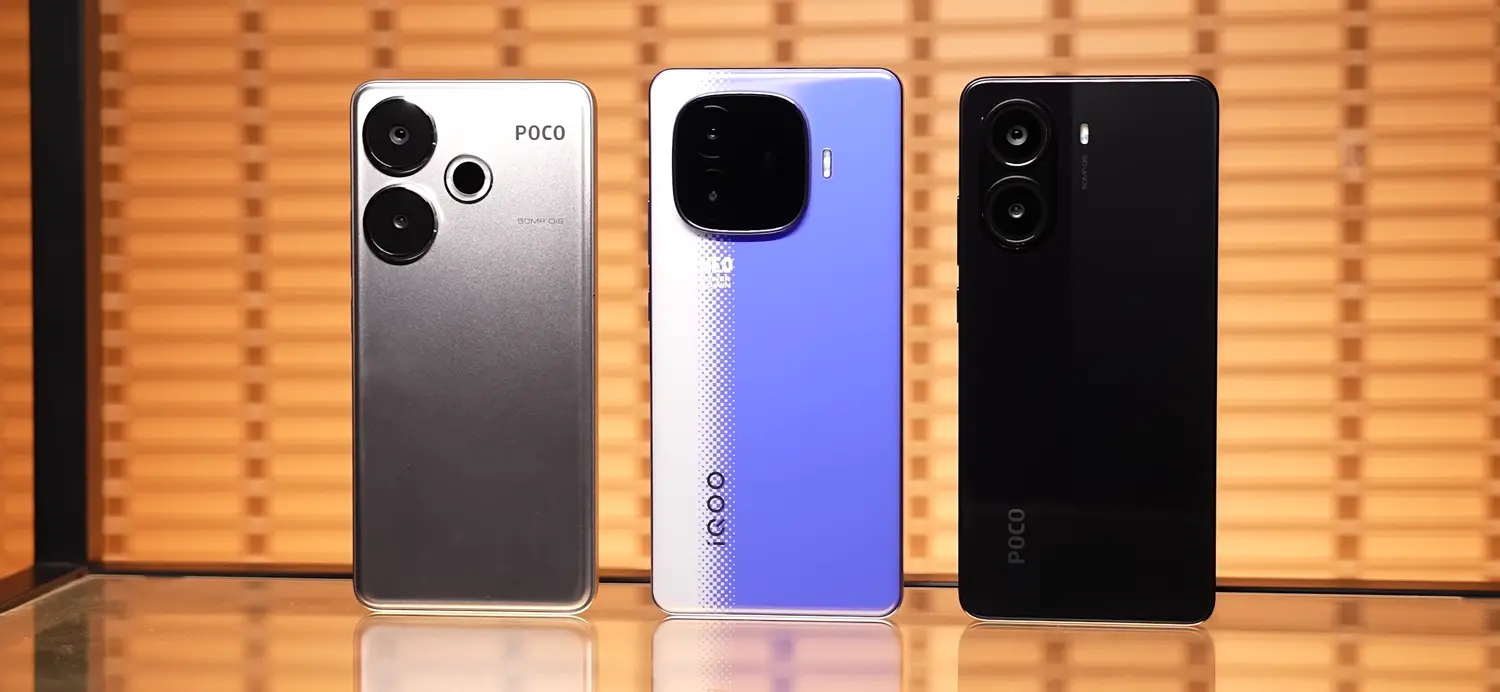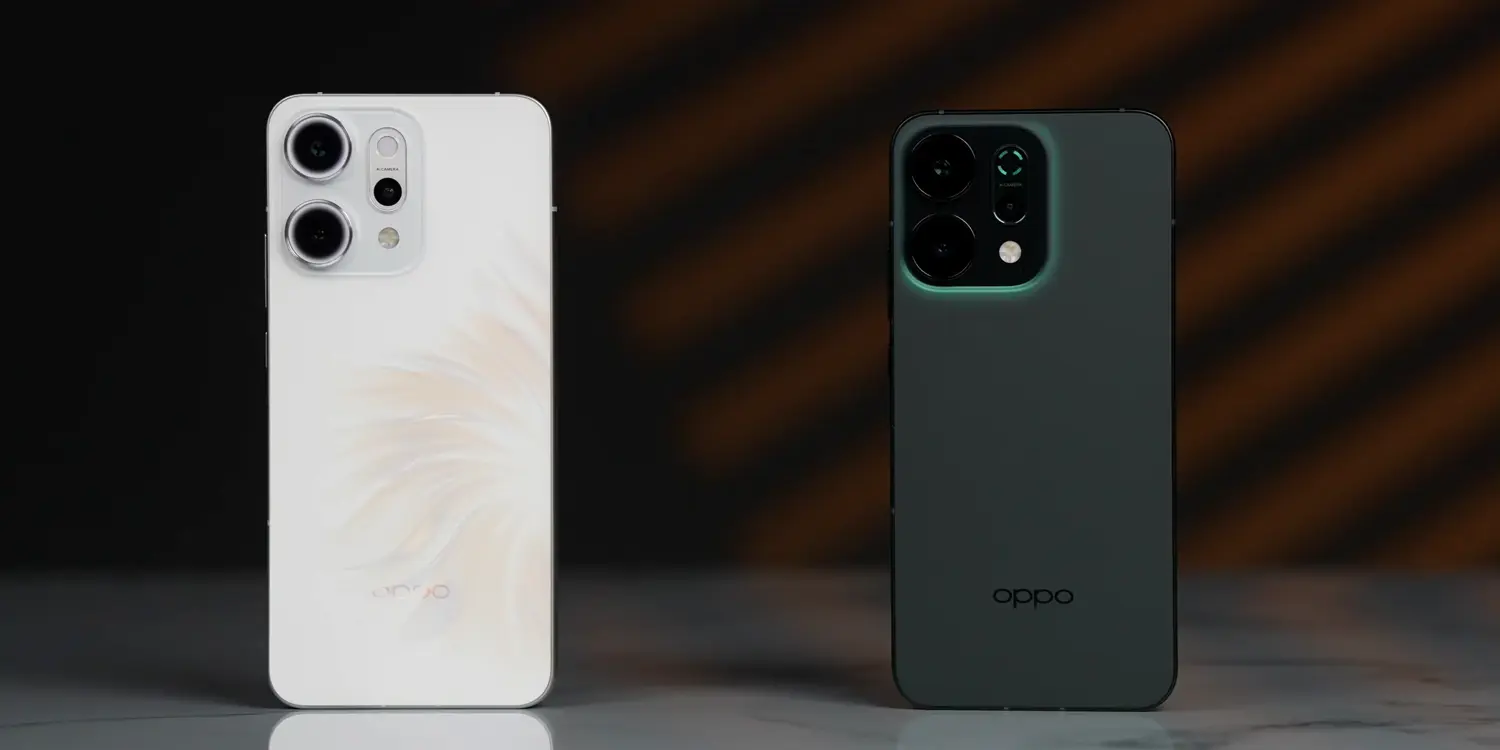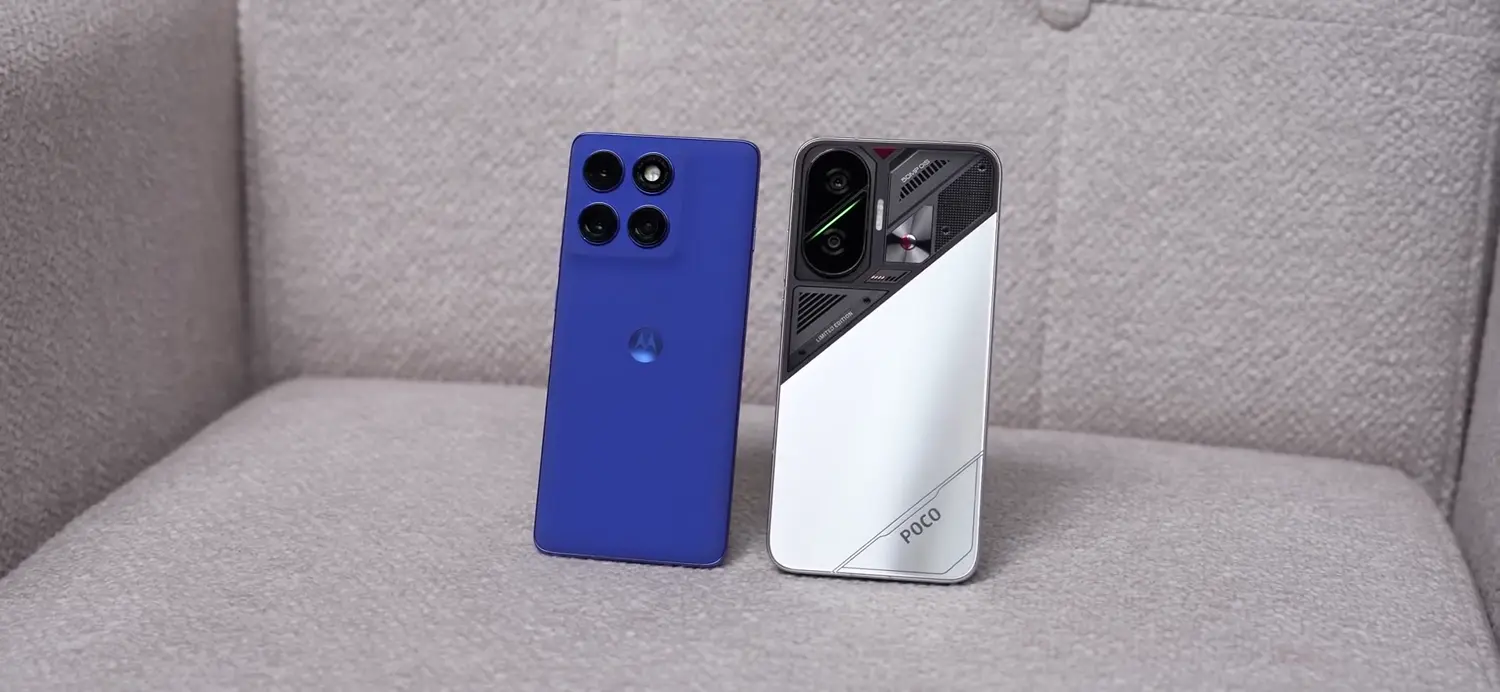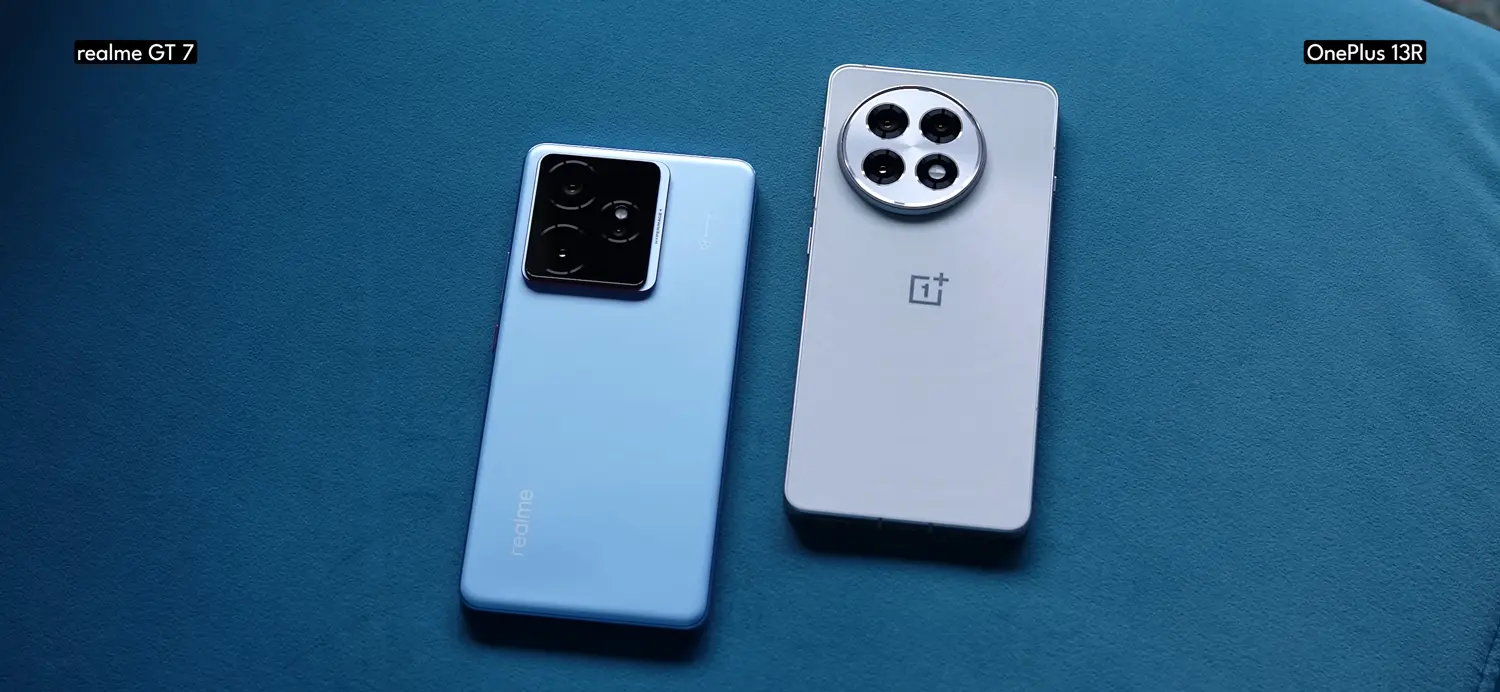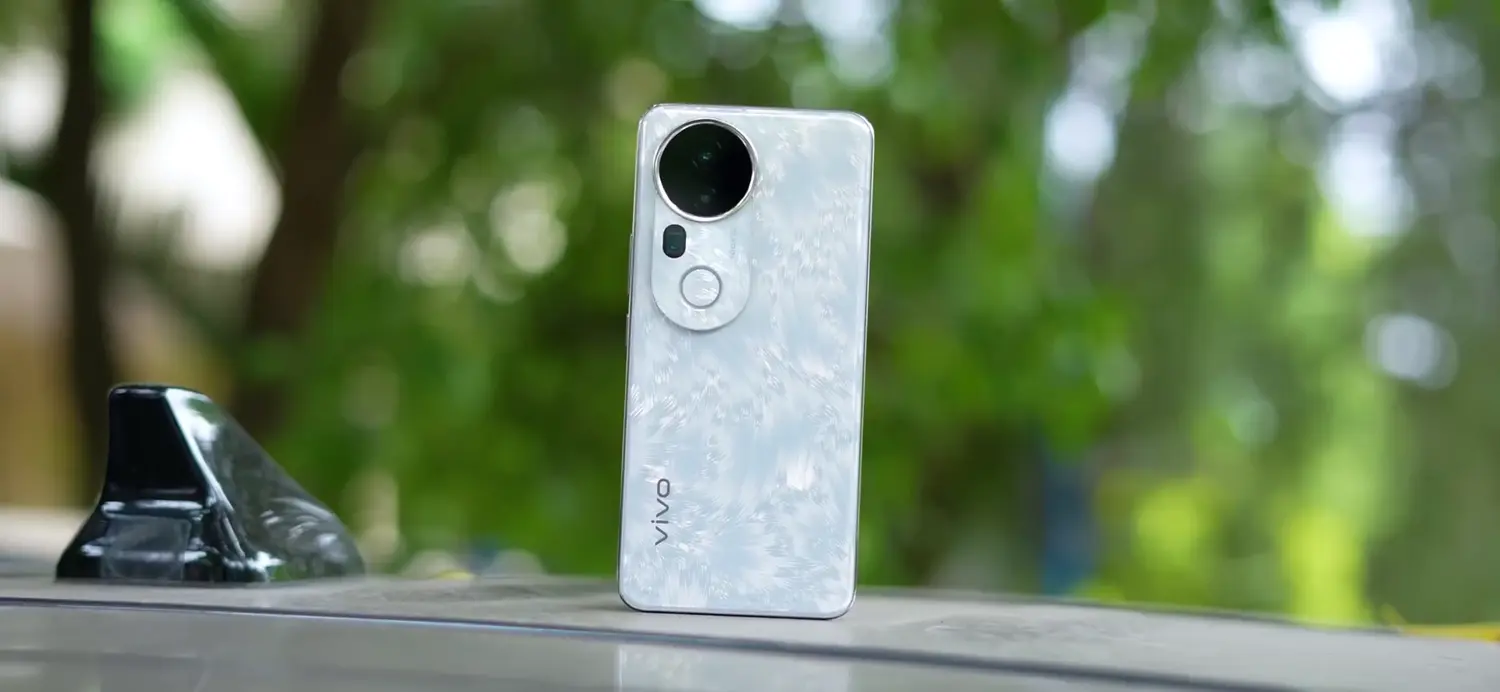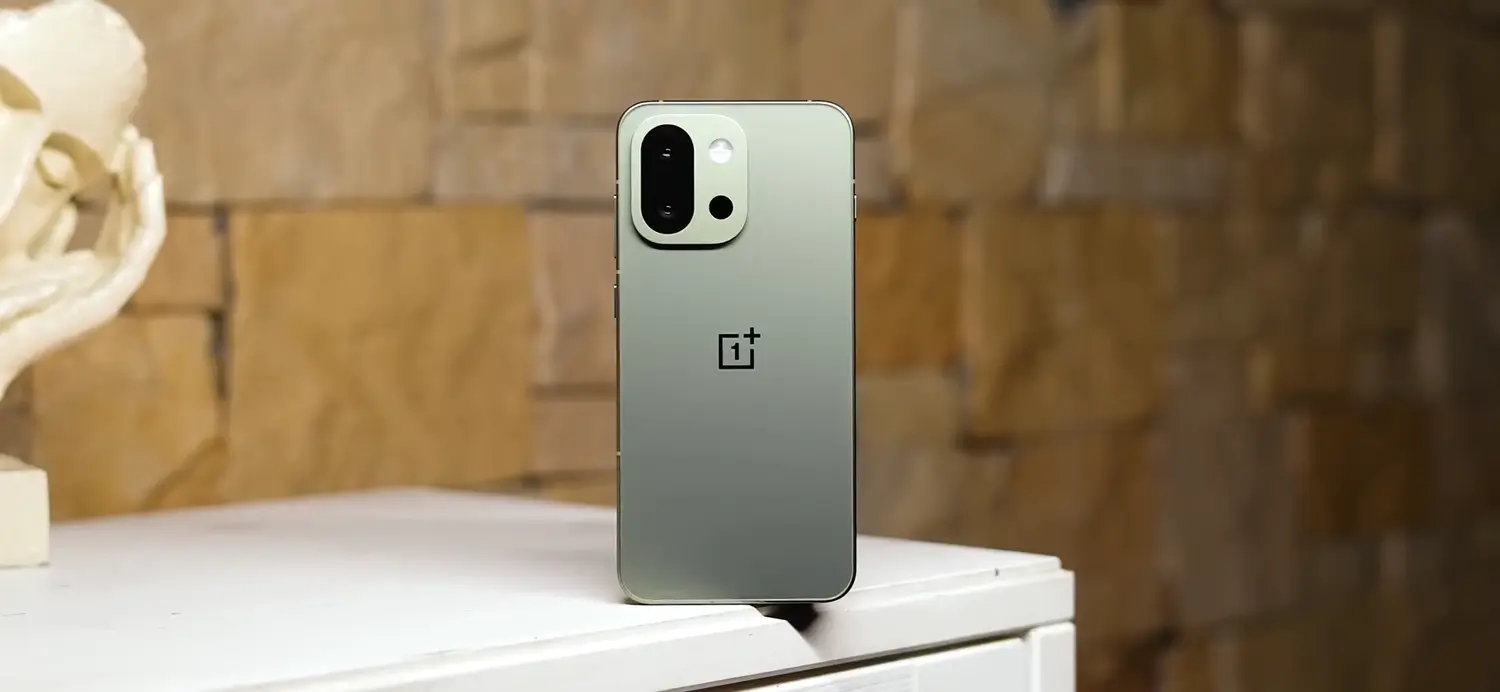The sub-₹30,000 smartphone segment in India is buzzing with options, and three devices that stand out are the iQOO Neo 10R, Poco F6, and Poco X7 Pro. These phones are performance beasts, offering top-notch specs at budget-friendly prices. However, choosing the right one can be tricky, especially when they share so many similarities. In this article, we’ll compare these three phones in detail, covering design, display, performance, camera, battery, and software to help you decide which one is worth your money. By the end, you’ll know which phone stands out and whether it’s the right pick for you.
Design and Build Quality
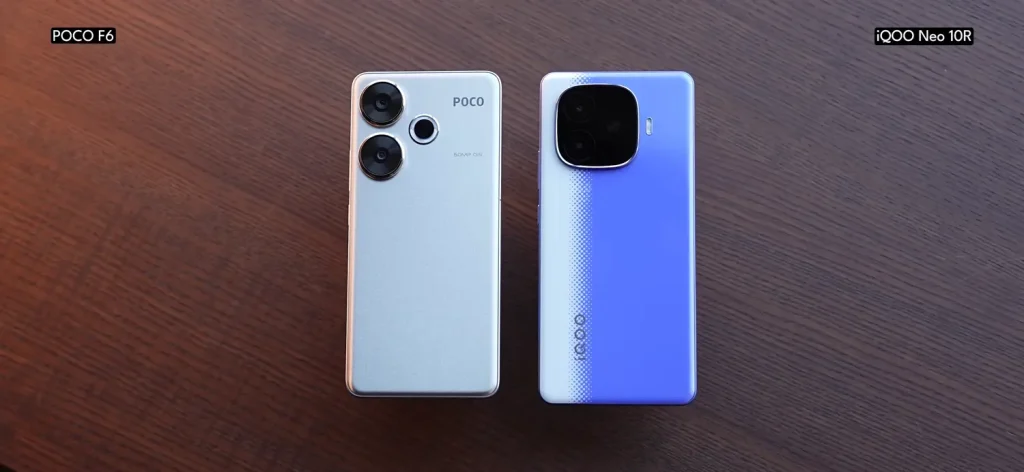
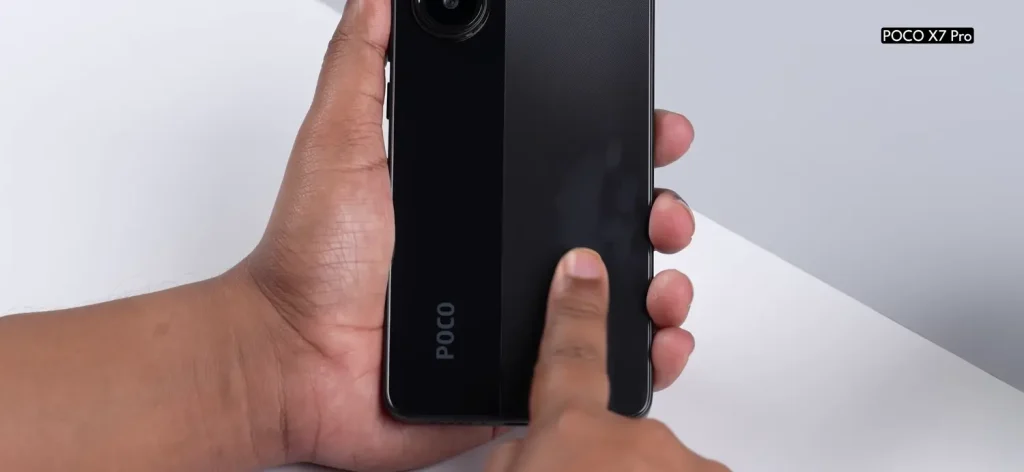
All three phones—iQOO Neo 10R, Poco F6, and Poco X7 Pro—use polycarbonate backs to keep costs down, but their designs have distinct vibes. The Poco X7 Pro tries to mimic glass with its glossy finish, but it’s a fingerprint magnet, which can be annoying for daily use. In contrast, the iQOO Neo 10R and Poco F6 embrace matte plastic, which feels more practical and resists smudges. The Neo 10R and F6 also have a slight curve, making them comfortable to hold. The Poco F6 takes a slight edge here as it’s the lightest, thanks to its smaller battery.
When it comes to durability, the Poco F6 shines with Corning Gorilla Glass Victus, offering better scratch and drop resistance compared to the Gorilla Glass 7i on the Poco X7 Pro and Schott Xensation on the iQOO Neo 10R. For water and dust resistance, the Poco X7 Pro leads with an IP68/IP69 rating, followed by the Neo 10R with IP65 and the F6 with IP64. If you’re prone to dropping your phone in water, the X7 Pro is the safest bet.
All three phones come with dual nano-SIM slots, an IR blaster for controlling appliances, and a USB 2.0 port. While USB 3.1 would’ve been nice for faster data transfer, it’s a compromise we can accept at this price point. Overall, the Poco X7 Pro wins for its premium water resistance, but the Poco F6 feels better in hand due to its lightweight design and stronger glass protection.
Display Quality
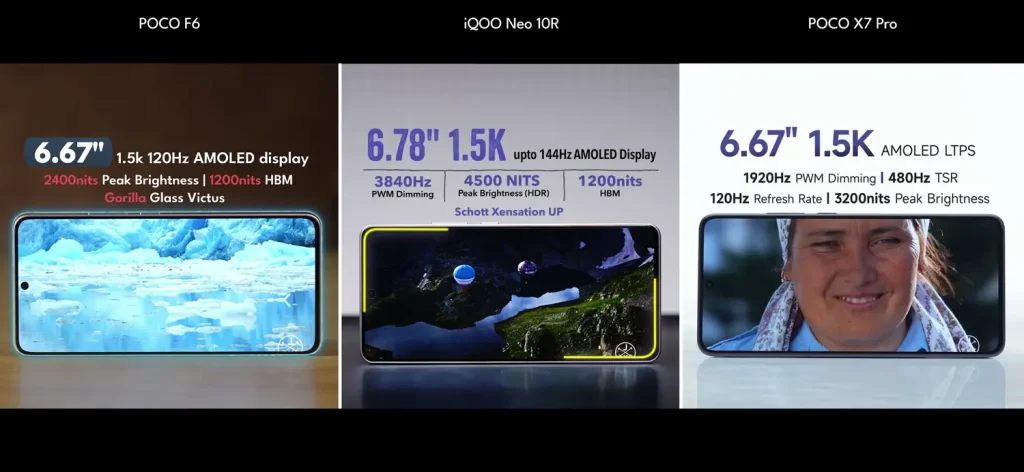
The iQOO Neo 10R, Poco F6, and Poco X7 Pro all feature 1.5K AMOLED displays, which deliver vibrant colors and deep blacks. However, there are some differences. The iQOO Neo 10R has the largest screen at 6.78 inches with a 144Hz refresh rate, making it the smoothest for scrolling and gaming. The Poco F6 and X7 Pro stick to 6.67-inch displays with a 120Hz refresh rate, which is still smooth but not as fluid as the Neo 10R.
In terms of brightness, the Poco X7 Pro leads with 1,400 nits in high-brightness mode (HBM), compared to 1,200 nits on the Neo 10R and F6. However, the Neo 10R shines in HDR content, offering flagship-grade control over highlights and shadows, even without Dolby Vision support (which both Poco phones have). The Neo 10R’s peak brightness hits 4,500 nits for HDR, making it ideal for watching Netflix or YouTube. All three phones handle low-light flicker well with high PWM dimming, and the Neo 10R takes a slight lead here.
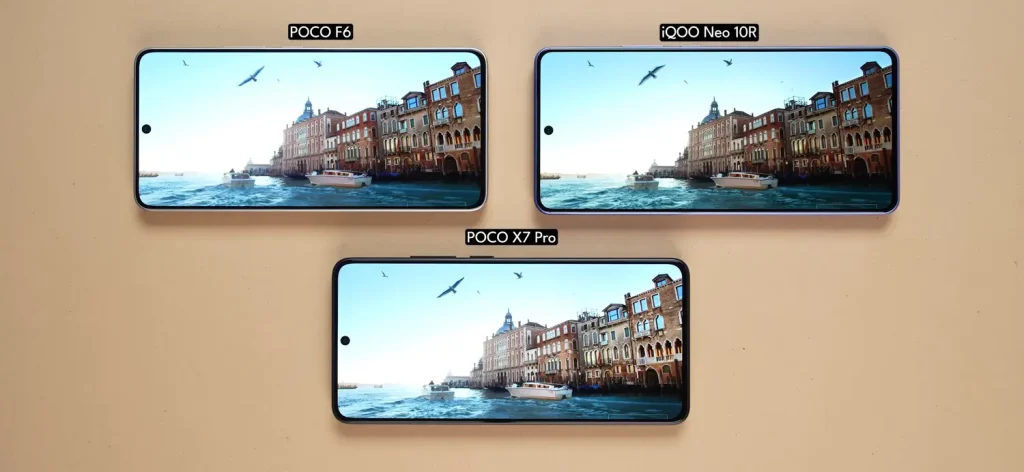
For multimedia, the Poco phones support Dolby Vision and Dolby Atmos, giving them an edge for streaming. However, the Neo 10R’s speakers sound richer, offering a better audio experience despite lacking Dolby Atmos. The touch sampling rate is 240Hz on the Neo 10R and 480Hz on the Poco phones, but the difference isn’t noticeable in daily use. All three have fast in-display fingerprint scanners and decent haptic feedback, with the Neo 10R offering the crispest vibrations.
If you prioritize a larger, smoother display with excellent HDR, the iQOO Neo 10R is the winner. For Dolby Vision and Atmos fans, the Poco phones are better.
Performance
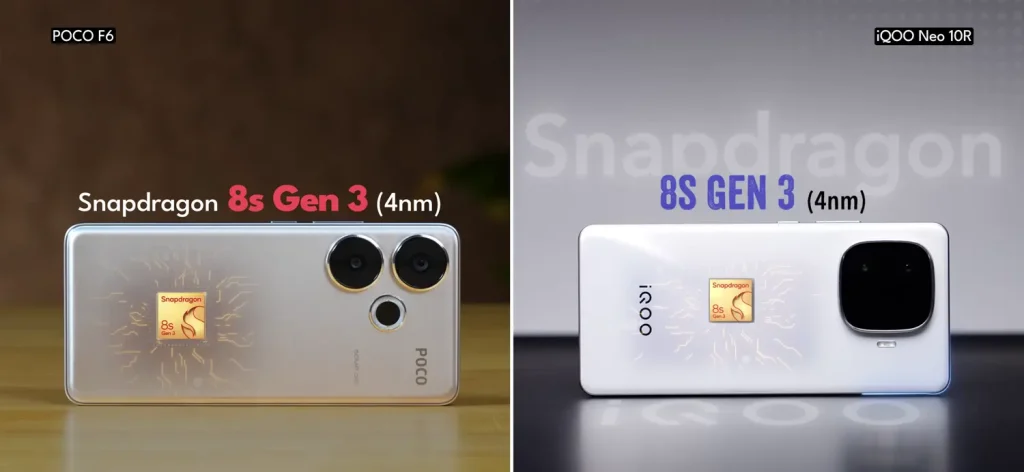
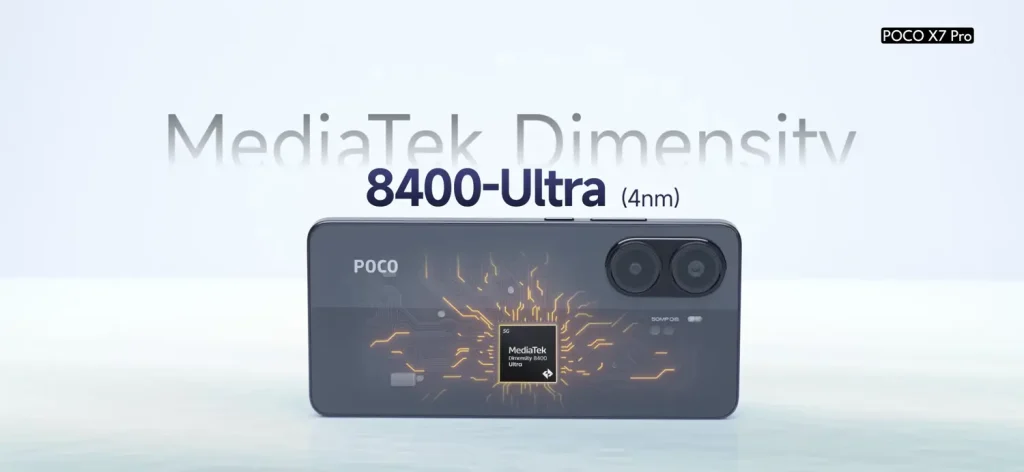
Performance is where these phones truly shine, and they’re designed for gamers and power users. The iQOO Neo 10R and Poco F6 are powered by the Qualcomm Snapdragon 8s Gen 3 chipset, while the Poco X7 Pro uses the MediaTek Dimensity 8400 Ultra. All three come with LPDDR5X RAM and UFS 4.0 storage (except the 128GB Neo 10R, which uses UFS 3.1).
In benchmarks, the Poco X7 Pro’s Dimensity 8400 Ultra takes the lead in multi-core performance, scoring higher in Geekbench and AnTuTu tests. However, the Snapdragon 8s Gen 3 in the Neo 10R and F6 is better for single-core tasks, which matter for apps like social media and browsing. In CPU throttle tests, the Poco F6 showed the best stability, followed by the Neo 10R, while the X7 Pro maintained higher sustained performance (67% vs. 44% for the Neo 10R).
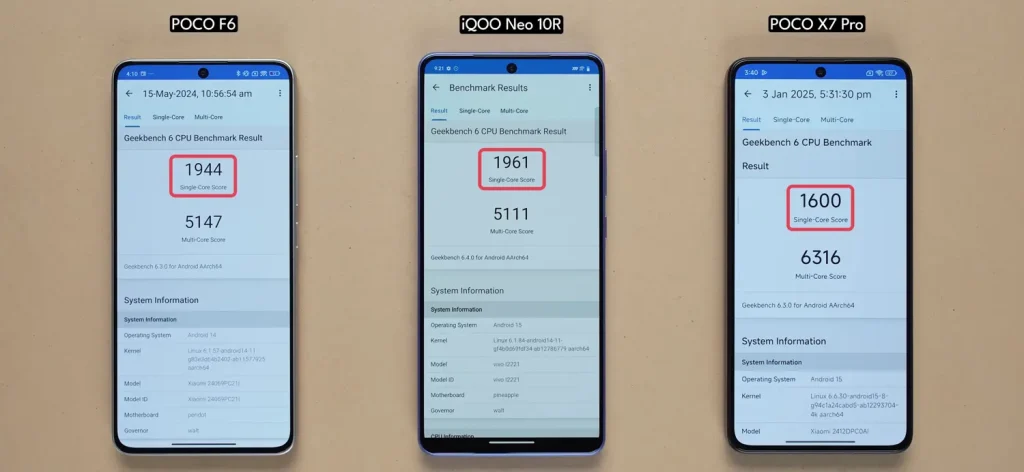
For gaming, the Neo 10R excels, delivering 59.8 FPS in Genshin Impact at max settings, compared to slightly lower performance on the Poco phones. The Neo 10R also supports 90 FPS in BGMI, as does the F6, but the X7 Pro lacks this despite its capable chipset. The Poco X7 Pro runs hotter (up to 51°C), while the Neo 10R manages thermals better, staying cooler during intense sessions. The Poco F6, however, drains the battery faster and hits 49°C.
For gamers, the iQOO Neo 10R is the best choice due to its high refresh rate, gaming-focused features (like a 2,000Hz touch sampling rate and 4D vibration), and excellent thermal management. The Poco X7 Pro is ideal for raw power, while the F6 offers a balance but struggles with heat.
Camera Performance
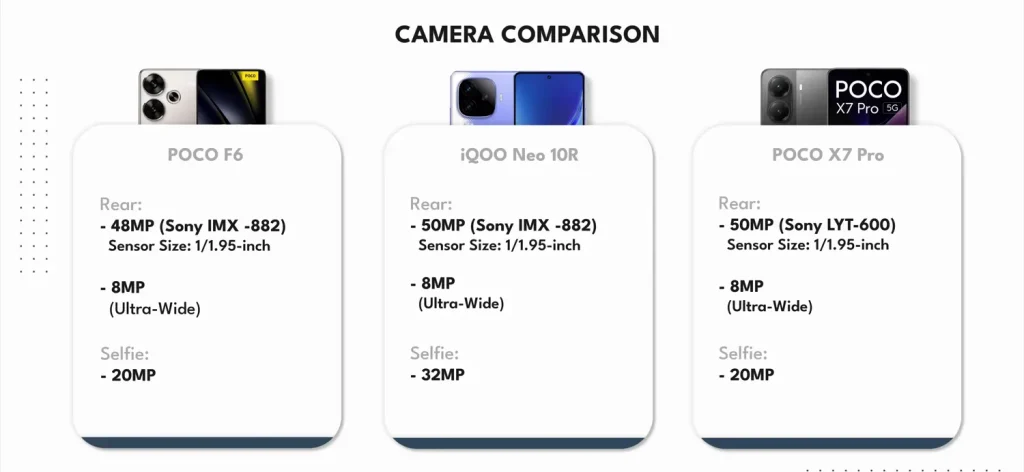
The camera setups on these phones are similar, with 50MP primary sensors (Sony IMX882 for Neo 10R and F6, Sony LYT600 for X7 Pro) and 8MP ultra-wide lenses. The selfie cameras differ: 32MP on the Neo 10R, 20MP on the F6, and 20MP on the X7 Pro.
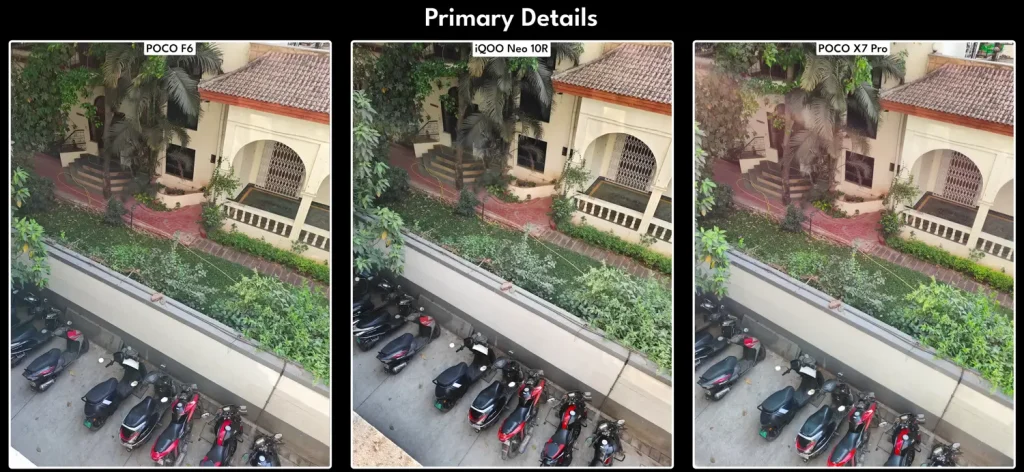
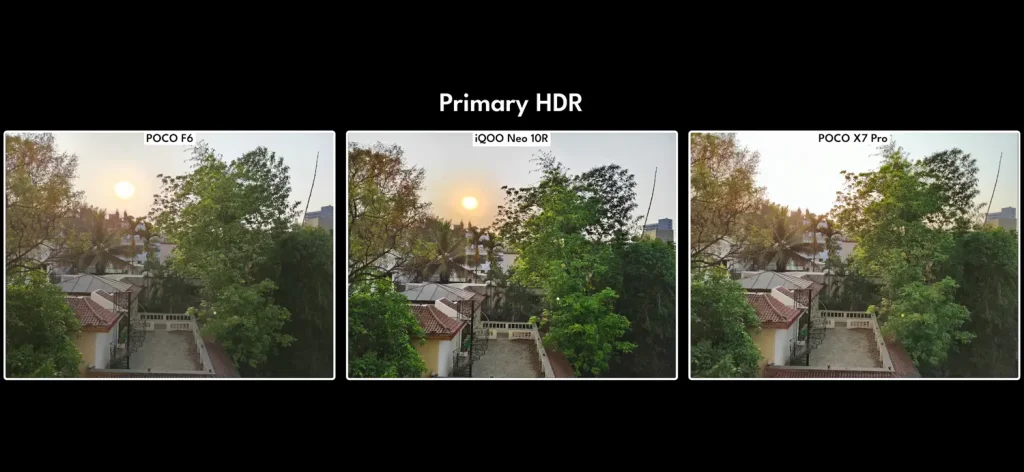

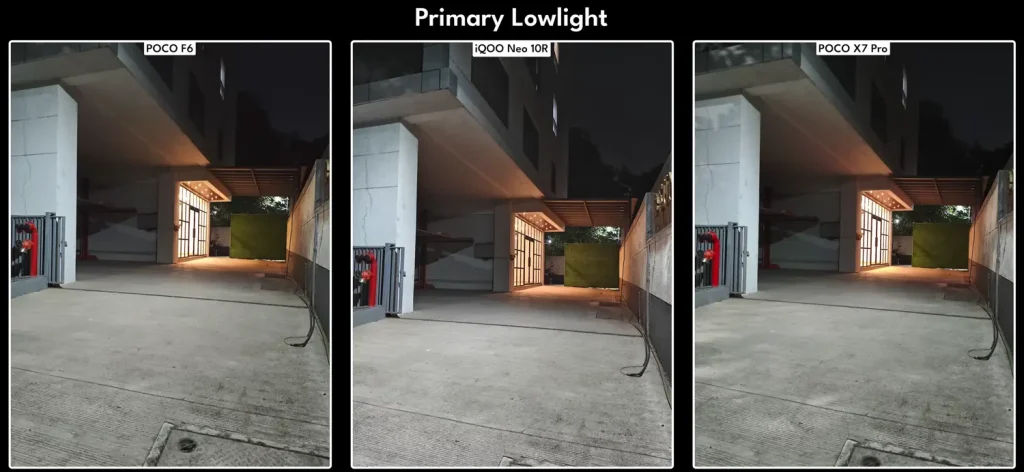
In daylight, all three capture decent details, but the Poco X7 Pro tends to oversharpen images, making them look unnatural. The iQOO Neo 10R produces the most natural colors, especially with its Natural Color Mode, while both Poco phones struggle with greens and reds. For HDR, the Neo 10R outperforms, offering better control over highlights and shadows across both lenses. Portrait shots are also better on the Neo 10R, with more natural bokeh compared to the slightly artificial blur on the Poco phones.
In low light, the Poco X7 Pro surprisingly captures more details, followed by the Neo 10R, with the F6 lagging. However, the ultra-wide cameras on all three are soft and underwhelming, especially in low light. For selfies, the Neo 10R and F6 are neck-and-neck, with better focus and brightness than the X7 Pro, which lacks detail.
Video recording is a strong suit for the Neo 10R, offering 4K 60 FPS with great stabilization and audio quality. The Poco phones also support 4K 60 FPS on the primary camera but are limited to 1080p 30 FPS for selfies, while the Neo 10R supports 4K 30 FPS. If photography and videography are priorities, the iQOO Neo 10R is the clear winner.
Battery Life and Charging
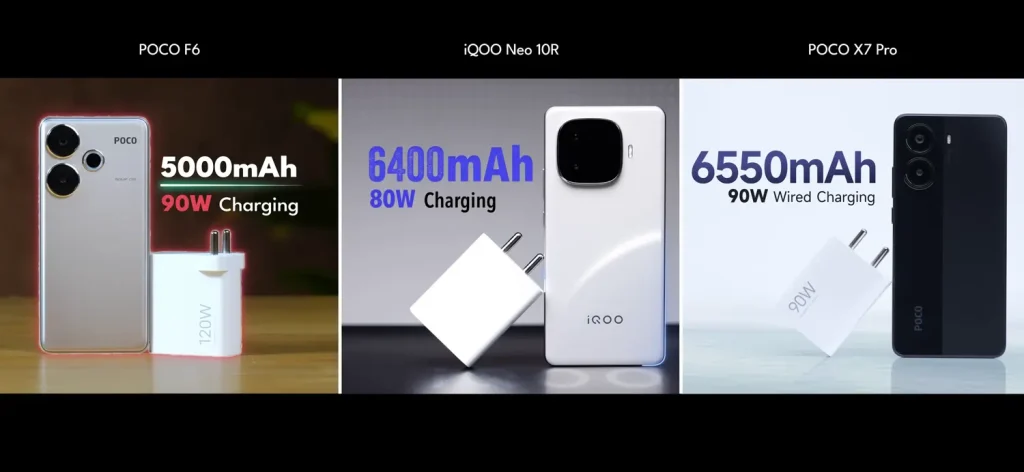
Battery life is a crucial factor, and these phones deliver impressive performance. The Poco X7 Pro has the largest battery at 6,550mAh with 90W fast charging, followed by the iQOO Neo 10R with 6,400mAh and 80W charging, and the Poco F6 with 5,000mAh and 90W charging.
In real-world tests, the iQOO Neo 10R lasts the longest, offering 11-12 hours of screen-on time, even with heavy gaming. The Poco X7 Pro manages 7.5-8 hours, which is decent but not great for its battery size, while the F6 lasts around 6 hours due to its smaller battery. In PCMark Battery tests, the Neo 10R outperformed the X7 Pro by nearly two hours, despite its smaller capacity.
For charging, the Poco X7 Pro is the fastest, taking about 47 minutes to charge fully, compared to 50-55 minutes for the Neo 10R and slightly less for the F6. However, the 10-minute difference isn’t a dealbreaker, especially given the Neo 10R’s superior battery life.
If battery life is your priority, the iQOO Neo 10R is the best choice. For faster charging, go with the Poco X7 Pro or F6.
Software Experience
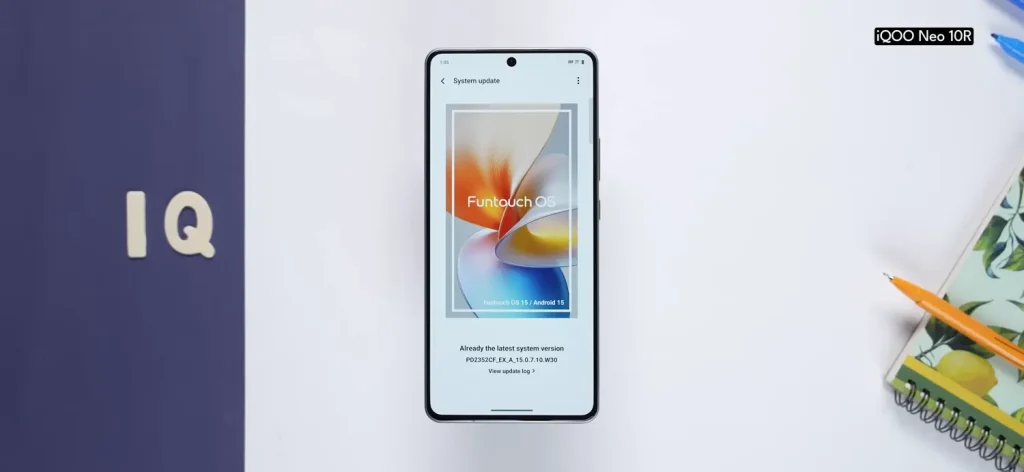
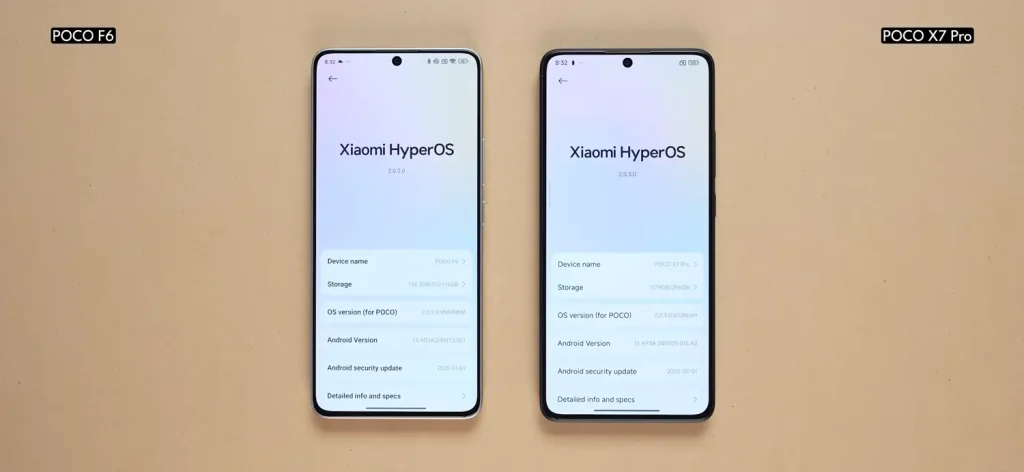
All three phones run Android 15, with the iQOO Neo 10R using Funtouch OS 15 and the Poco phones running HyperOS 2.0. Both promise 3 years of OS updates and 4 years of security patches, though the Poco F6, being older, may have one less OS update.
Funtouch OS 15 on the Neo 10R is cleaner with less bloatware and offers useful AI features like Circle to Search, AI image cutout, and object eraser. HyperOS 2.0 on the Poco phones has better animations and customization but comes with more bloatware. If you prefer a polished, practical software experience, the Neo 10R is the better pick.
Connectivity and Other Features
All three phones support 5G with multiple bands, ensuring good connectivity in India and abroad. They also offer Wi-Fi 6 and Bluetooth 5.4. The Poco phones have NFC support, which is missing on the Neo 10R—a downside if you use contactless payments. For high-resolution audio, the Poco phones support LHDC and LDAC codecs, while the Neo 10R only supports LDAC.
Pricing and Value for Money
The Poco F6 is the cheapest at around ₹22,999, followed by the iQOO Neo 10R at ₹26,999 (often under ₹25,000 with offers), and the Poco X7 Pro at ₹27,999. The F6’s lower price reflects its older launch, but newer phones like the Neo 10R and X7 Pro offer better features. The Neo 10R strikes the best balance, delivering excellent performance, camera, and battery life at a competitive price.
Specification Table
| Feature | iQOO Neo 10R | Poco F6 | Poco X7 Pro |
|---|---|---|---|
| Display | 6.78-inch AMOLED, 1.5K, 144Hz, 4,500 nits | 6.67-inch AMOLED, 1.5K, 120Hz, 2,400 nits | 6.67-inch AMOLED, 1.5K, 120Hz, 1,400 nits |
| Processor | Snapdragon 8s Gen 3 | Snapdragon 8s Gen 3 | MediaTek Dimensity 8400 Ultra |
| RAM/Storage | 8GB/12GB LPDDR5X, 128GB (UFS 3.1)/256GB (UFS 4.1) | 8GB/12GB LPDDR5X, 256GB (UFS 4.0) | 8GB/12GB LPDDR5X, 256GB (UFS 4.0) |
| Rear Camera | 50MP (IMX882, OIS) + 8MP ultra-wide | 50MP (IMX882, OIS) + 8MP ultra-wide | 50MP (LYT600, OIS) + 8MP ultra-wide |
| Front Camera | 32MP | 20MP | 20MP |
| Battery | 6,400mAh, 80W charging | 5,000mAh, 90W charging | 6,550mAh, 90W charging |
| Software | Funtouch OS 15 (Android 15) | HyperOS 2.0 (Android 15) | HyperOS 2.0 (Android 15) |
| Protection | IP65, Schott Xensation | IP64, Gorilla Glass Victus | IP68/IP69, Gorilla Glass 7i |
| Connectivity | 5G, Wi-Fi 6, Bluetooth 5.4, no NFC | 5G, Wi-Fi 6, Bluetooth 5.4, NFC | 5G, Wi-Fi 6, Bluetooth 5.4, NFC |
| Price | ₹26,999 | ₹22,999 | ₹27,999 |
Should You Buy?
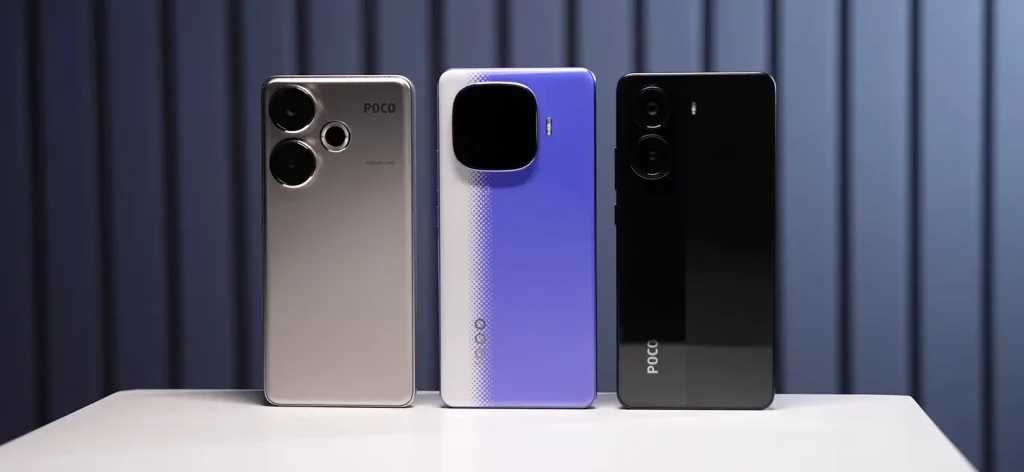
The iQOO Neo 10R is the best all-rounder under ₹30,000. It excels in battery life, camera quality, display smoothness, and gaming performance, making it ideal for most users. The Poco F6 is a budget-friendly option with strong performance and fast charging, but its smaller battery and older launch make it less future-proof. The Poco X7 Pro is perfect for raw power and water resistance but falls short in battery efficiency and camera tuning.
Is It Worth It?
If you want a phone that balances performance, camera, and battery life, the iQOO Neo 10R is worth every penny, especially at ₹26,999 (or less with offers). It’s a versatile choice for gamers, photographers, and everyday users. The Poco F6 is a great deal at ₹22,999 if you’re on a tighter budget, while the X7 Pro at ₹27,999 suits those prioritizing peak performance and durability.
Conclusion
After comparing the iQOO Neo 10R, Poco F6, and Poco X7 Pro, the Neo 10R emerges as the top pick. Its larger display, longer battery life, better camera, and gaming-focused features make it the most well-rounded choice under ₹30,000. The Poco F6 is a solid budget option, and the X7 Pro appeals to power users, but the Neo 10R nails the essentials for most buyers. If you’re looking for a phone that delivers on all fronts without breaking the bank, the iQOO Neo 10R is the one to go for.
